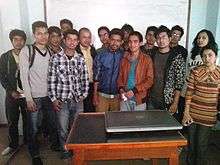Amrit Campus
 Nepali Wikimedia with OSAC in Amrit Campus | |
Former name | Public Science College |
|---|---|
| Type | Science College |
| Affiliation | Tribhuvan University |
| Location | Kathmandu Valley |
Amrit Campus, formerly known as Public Science College (PUSCOL), was named after late Amrit Prasad Pradhan. Pradhan was born in 1918 at Thamel, Kathmandu, Nepal. He served as the headmaster of Juddhodaya Public High School in Birgunj for two years and later joined Tri-Chandra College as a lecturer in Chemistry. In 1962, he became the founder Principal of Public Science College (at present Amrit Campus) and began teaching as Professor of Chemistry.
Late Principal Amrit Prasad Pradhan established Amrit Campus with a view to promote the study of science and technology in Nepal. He threw himself heart and soul into its development. The campus has benefited greatly from his spirit of enterprise, dedication and enthusiasm. While on a mission to the United States for a cause connected with the college, he died in an air crash over Mont Blanc on January 24, 1966.
Introduction
Amrit Campus (ASCOL), situated in the heart of Kathmandu Valley, is The only one pure science campus of the country.
The campus is a government institution, with partial decentralization, affiliated to Tribhuvan University. The campus offers different fields of study at Bachelor and Master's level. (It was providing Proficiency Certificate level too but due to recent abolishment of PCL, it is not part of this college.) The courses offered by ASCOL are
- Bachelor of Science in Mathematics(M), Statistics(S), Physics(P), Botany(B), Zoology(Z), Chemistry (C), Environmental Science (E) and Microbiology (m)(General B.Sc.)
The combinations possible are PSM,PCM,ESM,EPM,ECZ,CBZ,mCZ,mBC,EBC
- Bachelor of Science in Computer Science and Information Technology (B.Sc. CSIT)
- Master of Science in Mathematics (M.Sc. Mathematics)
- Master of Science in Physics (M.Sc. Physics)
- Master of Science in Chemistry (M.Sc. Chemistry)
- Master of Science in Botany (M.Sc. Botany)
Academic departments
- Department of Mathematics
- Department of Chemistry
- Department of Physics
- Department of Statistics
- Department of Zoology
- Department of Botany
- Department of Microbiology
- Department of Environmental Science
- Department of Computer Science and Information Technology(CSIT)
Organizations in Amrit Campus
Common and free of all ideology
- Tribhuvan University Teachers Association ASCOL Unit
- Tribhuvan University Bureaucratic Union ASCOL Unit
- Free Student Union
Organizations following Political ideology
Teacher's Organization
- Democratic Teacher's Union
- Progressive Teacher's Union
- Revolutionary national Teacher's union
Bureaucratic Union
- Democratic Bureaucrats Union
- Progressive Bureaucrats Union
- Revolutionary Bureaucrates Union
Student's Organizations
- ANNFSU
- Nepal Students' Union ASCOL Unit
- ANNISU(R) ASCOL Unit
Notable alumni
Notable alumni in the field of Science and technology
- Dr. Mahabir Pun (President of National Innovation, Leader of Nepal Wireless Project, Awardee: Ramon Magsaysay, Internet hall of fame,Ashoka Fellow, Scientist, Social entrepreneur)
- Prof. Dr. Bhanu Chandra Bajracharya (Mathematician, Former Chairperson of Department of Mathematics of ASCOL)
- Prof. Dr. Mana Raja Joshi (Mathematician)
- (Late) Prof. Dr. Dayananda Bajracharya (Botanist, Former Chairman of Central Department of Botany, Former Rector of Tribhuvan University, Former President of Nepal Academy of Science and Technology (NAST) formerly called Royal Nepal Academy of Sciences (RONAST))
- Associate Professor Madan Sakya (Zoologist, Former Campus Chief of Amrit Science Campus)
- Dr. Upendra Devkota
- Dr. Madhav Prasad Baral (Chemist and Founder of NIST college)
- Mr. Kulman Ghising (Managing Director, Nepal Electricity Authority)
Notable alumni in other fields
- Dr. Baburam Bhattarai (Former Prime minister of Nepal and former leader of UCPN (Maoist))
- Jhala Nath Khanal (Former Prime minister of Nepal and leader of CPN (UML))
- Prakash Man Singh (Deputy Prime minister of Nepal in the Cabinet led by Prime minister Sushil Koirala, General secretary of Nepali Congress)
- Dr. Minendra Prasad Rijal (Leader of Nepali Congress)
- Rukmangat Kattawal (Former Chief of Nepal Army)
- Kuber Singh Rana (Former IGP of Nepal Police)
- Amaresh Kumar Singh (Madhesi youth leader of Nepali Congress and Member of Parliament)
- Homraj Dahal (Former member of parliament of Nepal and leader of Nepali Congress)
- Pradip Paudel (Leader of Nepali Congress, Former President of Nepal Students' Union)
- Sagar Pandey (General Secretary of Trekking Association of Nepal)
- Buddhi Prasad Pudasaini (Co-ordinator of REHDON College)
References
Coordinates: 27°43′05″N 85°18′46″E / 27.71806°N 85.31278°E